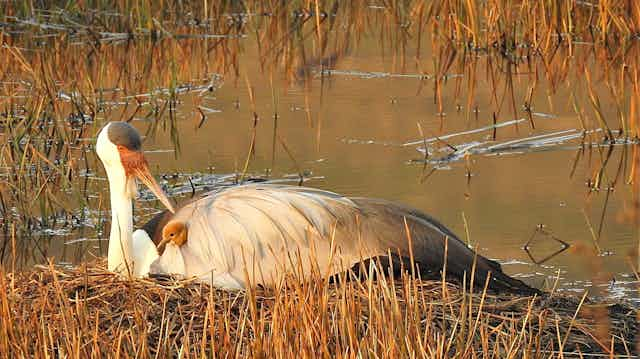Cranes are some of the world’s most majestic birds, with 15 species found globally. Four of these are found in Africa. The wattled crane in South Africa was in decline, but seems to have turned a corner. Its numbers have increased from just 188 birds in 2000 to 304 today. Crane researcher Lara Fuller explains how the population’s recovery recently led to it being moved from Critically Endangered to Endangered on the International Union for the Conservation of Nature’s list of threatened species.
What is so special about wattled cranes?
Wattled cranes are the largest crane species in Africa. They are only found on the continent and there are only about 9,600 left in Zambia, Botswana, Angola, Democratic Republic of Congo, Ethiopia, South Africa, Tanzania and Zimbabwe.
The tall birds (up to 180cm or six feet tall) have a wingspan of up to 2.6 metres wide and can weigh up to 8 kilograms. They’re the tallest flying African bird.
In the wild, the wattled cranes are estimated to live for about 30 years although older birds have been observed.
These birds carry striking colours and conduct spectacular mating rituals involving bowing, dancing and jumping. They symbolise grace, devotion, beauty and longevity.
What’s happened to the numbers?
Firstly, the number of breeding areas has increased. In 1999, there were only 70 breeding territories. Today, this has increased to 84 breeding areas in the wattled crane’s core population in the province of KwaZulu-Natal.
To count cranes, we use annual aerial surveys. We average the number of birds viewed over several years so that we are sure we get an accurate number.
In 2000, there were just 188 individual birds in KwaZulu-Natal. By 2005, the South Africa population had increased to 242 individual birds. By 2024, 304 individual birds were found.
How did the wattled cranes move from Critically Endangered?
The International Union for the Conservation of Nature keeps lists of how endangered all animals are globally. This helps scientists and society know when an animal is edging closer to extinction.
When an animal becomes less endangered through a conservation success, this is known as downlisting. In the case of the wattled cranes, their downlisting from Critically Endangered to Endangered was achieved by the Endangered Wildlife Trust and the International Crane Foundation working with landowners where the birds live to restore their habitats.
Where do wattled cranes live?
The biggest number of these birds living together in Africa is found on the southern-central floodplains (areas of flooded grasslands found in different countries across southern and central Africa). There are two smaller populations in Ethiopia and South Africa.
Most wattled cranes in South Africa inhabit the foothills of the Drakensberg mountain range. This area provides a large amount of drinking water to numerous towns and settlements.
Wattled cranes live in wetlands and grasslands in the area. The wetlands form between 10% and 40% of their breeding territory, and the surrounding natural grasslands make up about 20% to 80% of their nesting territory.
Grasslands are crucial to the health of wetlands. They keep soil stable and prevent erosion and siltation of the wetland. These areas also provide water to people through naturally occurring springs. These are often used by rural villages, and without them, many communities would not have access to drinking water.
Grasslands are also foraging areas for the family of wattled cranes as the chick becomes larger. Wattled cranes eat water lilies and other water plants, water insects, snails, and frogs found in wetlands.
The birds breed in wetlands, where there is enough food available for chicks to grow one inch (2.54 cm) per week after they hatch.
The chicks only start flying when they are several weeks old. Until then, wetlands act as natural moats, protecting chicks from being eaten by predators.
Wetlands are often seen as muddy, damp, insect ridden and smelly places. In South Africa in the 1970s, 50% of the country’s wetlands were drained and turned into commercial agricultural lands or degraded. As South Africa is also considered a water scarce country, this action had a devastating result and is partly the reason why the wattled cranes became critically endangered.
When rain falls in abundance, wetlands soak up the water, slowing the flow down and reducing flooding. This saves a lot of damage to infrastructure and prevents soil erosion in natural areas. Wetlands are also a natural water purification system – they clean pollutants from the water, and deliver water that is much cleaner than it was when it soaked into the wetland.
Where wattled cranes are found breeding in wetlands, it is a clear sign that the wetland is healthy and thriving. The wellbeing of people, cranes and wetlands is intricately linked.
How can the wattled crane be protected further?
The size of the wattled crane population in KwaZulu-Natal – fewer than 400 birds – makes it incredibly vulnerable to catastrophic events, such as disease. This would put the species at risk of extinction in South Africa.
Wattled cranes need more breeding sites to increase their populations. Wetlands need to be rehabilitated and restored, because the birds won’t mate and breed in degraded or polluted wetlands. Environmentalists and the birds will be relying on the goodwill of landowners and everyone who uses wetlands to support this and help keep wetlands clean.
We plan to deepen our work in restoring wetlands. We aim to restore wetlands in other parts of South Africa too so that wattled cranes can go back into these habitats and continue to breed.
Lara Fuller works for two NPO’s the Endangered Wildlife Trust and the International Crane Foundation. These orgainsations receives funds from multiple bodies.
By Lara Fuller, Honorary Research Associate: School of Life Sciences, University of KwaZulu-Natal


